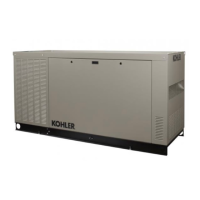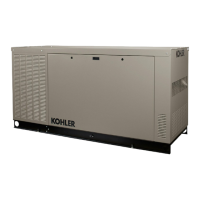TP-6811 7/16 55Section 4 Cooling System
4.4 Cooling System Inspection
To prevent generator shutdown or damage because of
overheating:
D Keep the cooling air inlets clean and unobstructed.
D Inspect the radiator’s exterior for obstructions and
remove dirt and foreign material with a soft brush or
cloth to avoid damaging the radiator fins.
D Check the hoses and connections for leaks and
replace any cracked, frayed, or spongy hoses.
D Check the condition and tension of the radiator water
pump belt(s).
D Check the rubber seal of the radiator’s pressure cap.
Remove dirt and other debris from the pressure cap
and filler neck. Replace a cracked or deteriorated
cap.
4.5 Checking and Filling Coolant
Maintain the coolant level in the coolant overflow bottle
between the High and Low markings. See Section 1,
Service Views, for the coolant overflow bottle location.
Note: Periodically check the coolant level by removing
the radiator’s pressure cap. Do not rely solely on
the level in the coolant overflow bottle.
Add fresh coolant until the level is just below the
overflow tube opening. Use a coolant mixture of 50%
ethylene glycol and 50% clean, softened water to inhibit
rust/corrosion and prevent freezing.
A coolant solution of 50% ethylene glycol provides
freezing protection to --37C(--34F) and overheating
protection to 129C (265F). A coolant solution with less
than 50% ethylene glycol may not provide adequate
freezing and overheating protection. A coolant solution
with more than 50% ethylene glycol can cause engine or
component damage. Do not use alcohol or methanol
antifreeze or mix them with the specified coolant.
4.6 Draining Cooling System
The radiator contains a coolant drain valve to drain the
cooling system. When draining the coolant, remove the
radiator’s pressure cap, which will allow the entire
system to drain and will prevent air pockets from forming
and restricting coolant passage to the block.
1. De--energize the block heater, if equipped.
2. Remove the pressure cap to allow the entire
system to drain and prevent air pockets from
restricting coolant flow through the engine block.
3. Open the coolant drain valve and allow the system
to drain.
4. If the inside of the radiator has mineral deposits or
the used coolant contains dirt or grease, go to
Section 4.7, Flushing and Cleaning. If the cooling
system does not have mineral deposits, refill the
cooling system as instructed in Section 4.8, Filling
Cooling System.
4.7 Flushing and Cleaning
For optimum protection, drain, flush, and refill the
cooling system at the interval listed in the service
schedule.
Flushing and Cleaning Procedure
1. Flush the system with clean water.
2. Drain, clean, and flush the coolant overflow bottle.
3. Refill the cooling system as instructed in
Section 4.8.






